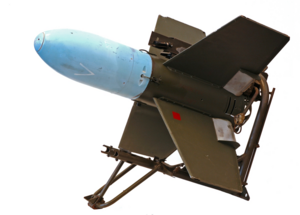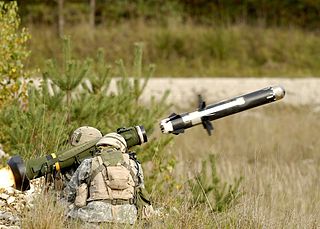
An anti-tank guided missile (ATGM), anti-tank missile, anti-tank guided weapon (ATGW) or anti-armor guided weapon is a guided missile primarily designed to hit and destroy heavily armored military vehicles. ATGMs range in size from shoulder-launched weapons, which can be transported by a single soldier, to larger tripod-mounted weapons, which require a squad or team to transport and fire, to vehicle and aircraft mounted missile systems.

A wire-guided missile is a missile that is guided by signals sent to it via thin wires connected between the missile and its guidance mechanism, which is located somewhere near the launch site. As the missile flies, the wires are reeled out behind it. This guidance system is most commonly used in anti-tank missiles, where its ability to be used in areas of limited line-of-sight make it useful, while the range limit imposed by the length of the wire is not a serious concern.
Manual command to line of sight is a method for guiding guided missiles.
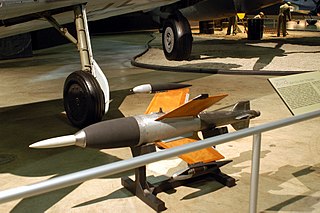
The Ruhrstahl Ru 344 X-4 or Ruhrstahl-Kramer RK 344 was a wire-guided air-to-air missile designed by Germany during World War II. The X-4 did not see operational service and thus was not proven in combat but inspired considerable post-war work around the world, and was the basis for the development of several ground-launched anti-tank missiles.

The BGM-71 TOW is an American anti-tank missile. TOW replaced much smaller missiles like the SS.10 and ENTAC, offering roughly twice the effective range, a more powerful warhead, and a greatly improved semi-automatic command to line of sight (SACLOS) that could also be equipped with infrared cameras for night time use.

Nord-Aviation was a state-owned French aircraft manufacturer. The bulk of its facilities were based on the site of Bourges airport, in the département of Cher, in central France.

The MGM-5 Corporal missile was a nuclear-armed tactical surface-to-surface missile. It was the first guided weapon authorized by the United States to carry a nuclear warhead. A guided tactical ballistic missile, the Corporal could deliver either a nuclear fission, high-explosive, fragmentation or chemical warhead up to a range of 75 nautical miles (139 km).

The Vickers Vigilant was a British 1960s era MCLOS wire-guided anti-tank missile used by the British Army. It was also licence-built in the United States by Clevite for the US Marine Corps, and sometimes known as Clevite rounds in this case.

The 9M14 Malyutka is a manual command to line of sight (MCLOS) wire-guided anti-tank guided missile (ATGM) system developed in the Soviet Union. It was the first man-portable anti-tank guided missile of the Soviet Union and is probably the most widely produced ATGM of all time—with Soviet production peaking at 25,000 missiles a year during the 1960s and 1970s. In addition, copies of the missile have been manufactured under various names by at least six countries.

The 3M6 Shmel is an MCLOS wire-guided anti-tank missile of the Soviet Union. Its GRAU designation is "3M6" and its NATO reporting name is AT-1 Snapper.

ENTAC or MGM-32A was a French MCLOS wire-guided anti-tank missile. Developed in the early 1950s, the weapon entered service with the French Army in 1957. Production ended in 1974 after approximately 140,000 had been built.

The SS.11 is a French manual command to line of sight wire-guided anti-tank missile manufactured by Nord Aviation. It is also available in the air-to-ground version, AS.11, which featured a stabilized sighting system. The AS.11 was also known as the AGM-22 in American service. It is among the earliest guided anti-tank missiles, entering service with the French Army in 1956 and remaining in service into the 1980s. It also formed the basis for the larger and longer-ranged SS.12/AS.12 series.
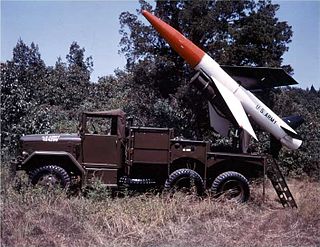
The MGM-18 Lacrosse was a short-ranged tactical weapon intended for close support of ground troops. Its first flight test was in 1954 and was deployed by the United States Army beginning in 1959, despite being still in the development stage. The program's many technical hurdles proved too difficult to overcome and the missile was withdrawn from field service by 1964.

The Mathogo is an Argentine first-generation wire-guided anti-tank missile.
The DRDO Anti-Tank Missile is a first generation wire-guided anti-tank guided missile (ATGM) developed in India by Defence Research and Development Laboratory (DRDL), a part of the Defence Research and Development Organisation (DRDO). It has a subsonic speed up to 300 ft/s (91 m/s) with a range of 1.6 km (0.99 mi) and carries a 106 mm high-explosive anti-tank (HEAT) warhead.
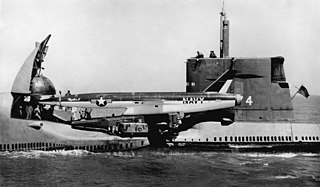
The SSM-N-9 Regulus II cruise missile is a supersonic guided missile armed with a nuclear warhead, intended for launching from surface ships and submarines of the U.S. Navy (USN).

The XSSM-A-23 Dart was an anti-tank guided missile developed for the United States Army in the 1950s. After protracted development, the missile, similar in design to the French SS.10, was cancelled in favor of purchasing the SS.11 missile.
